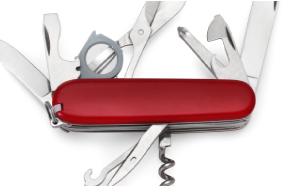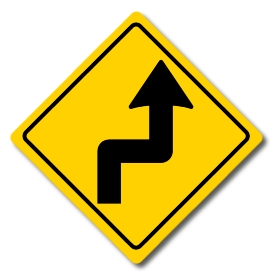Great Performances
Resourceful Leadership
One of the essential characteristics that every customer-centric organization shares is a culture of resourcefulness. It starts with the organization’s leaders. Their vision is practical, and even frugal, and it translates into the culture of everyone working there. The message is clear: “Focus on our customers rather than ourselves.” An excellent example is Barlean’s Organic […]
Corporate Follow-Up
I always want to know the back story of feel-good customer service stories.
Recently, a young traveler, with no money, was fed for free by the Wolfgang Puck restaurant in Chicago-O’Hare Airport. It’s a great story.
But I wanted to know how the executives of the organization handled the situation after it happened. I wrote to the Contact Us portal on the Wolfgang Puck website. Here is the response that I received from Lesley within a few minutes of my online request:
Adaptability for Customers
What it means to work with customers is inevitably evolving. It’s crazy to believe that the culture which a company had twenty years ago could connect with customers today. It must be adaptive.
Improv for Customers
The lessons of improv comedy for businesses are to allow freedom to explore new areas that will make the connection with customers (or the audience). Instead of being restricted by what you perceive as rules, be open to where your customers want you to go. Be natural, but with a sense of play. Enjoy the freedom to say “yes…and” if the results are better for the customer.
Customer 3D and Disappearing Problems
Customer 3D solves problems, but not in the ways you might expect. Becoming customer-centered weaves a single worldview through the fabric of the organization. It's amazing how many other internal issues get resolved when the customer is your first priority.
The Time Spent on Customers
Customer 3D™ businesses focus on identifying new opportunities. Whereas product-centered companies during “down” times ask customers for additional orders on existing products, Customer 3D™ organizations look for new products and processes for customers.
A Lot of People Can Sing…
But we don’t pay attention until they are really good. Exceptionally customer-centered organizations have an energy that attracts faithful customers who have noticed what makes them different and rewarded them with go-nowhere-else loyalty. Customers show up because of the company and the product is no longer part of the decision. They already know the product is going to be good.
Resourceful Leadership
All customer-centered businesses have confidence in their capabilities and inventiveness. Their leaders educate the organization by modeling creativity and calling on inner resources to take care of every situation.The message is clear: “Focus on our customers rather than ourselves.”
What Does WOW Mean?
In order to WOW customers, change your culture from supplier-focused to customer-focused. Thinking like a customer will make it clear to everyone what WOW means.
Creativity Focused on Customers
Use creative ways shake up your thinking and to open “the floodgates of inspiration.” Lisa Aschmann's song scenarios provide innovative ideas for doing great things for customers.
Customer-Centered Systems
One simple transaction can build an incredible amount of trust. Redbox took a potentially one-dimensional problem report and turned it into a three-dimensional experience for its customer.
The Pronoun Test
A simple pronoun can mean the difference between sustainability and stagnation for an organization. Customer-centered workplaces always think “outside-in” by figuratively bringing their customers inside and reflecting a mindset of helping the customer succeed.
Two Ways to Innovate
Innovation happens when organizations think like their customers. The approach should be built on the goal of making the exception the rule. Organizations should constantly be looking for a better way to accomplish what they are doing. And it should always be based on the real-world needs of the customer.
High Amplitude
The power of customer-centricity is strongest at Levels 2 and 3, which create a balanced system that permeates the internal silos that exist in most businesses. These high-level, customer-centered strategies produce higher loyalty and customer closeness in organizations that embrace them.
Change Needs Creative Ideas
Teams should use creative storytelling to sell customer-connection ideas within their organizations. Visual examples will make the argument more convincing.Clear reasoning will take you from a state of “I think we should…” to “Here is what change will mean to our customers.”
Unmet Customer Needs
Tomorrow’s success does not come from yesterday’s thinking. Dramatic change can only happen through commitment to a heuristic system which enables organizations to focus on designing products and services driven by customers’ needs.
Customer-Centered Decision Trees
Default procedures offer companies the chance to save their customers time and money, and help them maneuver through complexity. In every process, however, leaders should imagine themselves in the shoes of the people they serve.
Three Levels of Customer Purpose
Level 3 is transformational. At this stage, organizations have created a system that is based on design thinking, which makes us attentive, like a good designer and helps us “discard pre-existing ideas” about what customers value.
Customers Want Simplicity
Avoid complexity for your customers. The best way to prove yourself to them is to make their lives simpler.
Customer-Centric Managers
A few passionate managers can change the culture in an organization by leading their team toward customer-centricity. Executive leadership must set the tone and direction for customer-centricity. But middle managers are in the best position to know when to take off the training wheels and make change happen.
Customer-Centric Problem Handling
Research which we do for our clients indicates time and time again that customers who reported a problem and were delighted with the outcome have higher satisfaction than the ones who never experienced a problem at all. Why would any company simply want to break-even with these opportunities? Service recovery should energize the organization to become more customer-centered.
An Early Warning System
“There’s no such thing as good news or bad news. There’s only fast news and slow news.” Fast knowledge happens within organizations that are connected and proactively communicating with their customers. Every organization should have an early warning system. The best one is built around closeness with your customers.
Fluency
Success requires collaboration so that the entire organization is “speaking the customer’s language.” Communication is inevitably poor when it's one-sided. Focusing on customers is the most important dimension of your culture; delivery must be as fluent as possible.
How to Answer Questions
Amazon.com continues to be a successful, strong brand because it always answers its business questions—strategic and day-to-day—with a solution that includes “the customer.” Jeff Bezos, Amazon's CEO, has given the world insight into how he leads the Amazon organization through a series of interviews over the years. I believe the best is “The Institutional Yes” […]
Tells
Tells are indicators of what others see in you—how you will behave in any situation. Customers use all of your interactions with them to form an impression of how you will treat them as customers in the future. It is really important to understand these tells and to manage them deliberately because customers judge your […]
I Know All the Right Answers
Much of our client work involves assisting leaders in developing their organizations to become more customer-centered. But what if the leaders don't get it? What if they think they know all the right answers about customers already? A phrase that you hear a lot these days is "They don't know what they don't know". I […]
Extraordinary
There is a simple method for outperforming and growing your business. It involves what author Jim Champy describes as "finding something that you can do better than your competitors." Every process that touches your customers represents an opportunity to distinguish your organization as better in the eyes of your customers. Here's how you can identify […]
The Multiplier Effect (Part II)
It is fantastic news that great performance, grounded in being customer-centered, is available for every business if it wants it. It grows out of deliberate practice and design of an organization-wide culture to improve on behalf of your customers. There is another dimension of the multiplier effect that will add even more to your image […]
The Multiplier Effect (Part I)
The more you do something, the better you get at it. We are familiar with this concept in sports and music, because the more you practice, the better you become. The same thing applies in leading your organization to become more customer-centered. In economics, a multiplier effect describes the degree of change in one variable […]
Greatness Without Customers?
It's amazing how organizations believe they can become great while ignoring their customers. Jim Collins' How The Mighty Fall: And Why Some Companies Never Give In builds off of his Good to Great and Built to Last tenets to analyze how successful companies get better, or conversely, how they decline. He describes how companies can under-perform by […]
Right-Brain Business Goals (I)
Much has been written recently about right-brain thinking—and it is long overdue. Business has traditionally been left-brained, but its ability to search for greater efficiencies and to innovate while lowering costs has reached a plateau. The new opportunity to take performance to the next level is through right-brain thinking. A shift to this approach signifies […]
The Last Question First
Alan Webber's Rules of Thumb is an absolute must-read. It is quintessential to leading your organization through the next day, week, year and beyond. It is game-changing, but simple. It is practical and inspiring at the same time. And it weighs in solidly on thinking like a customer. For example, Webber's Rule #3 is ‘Ask the […]
Loyalty Programs are Changing
Last week, I attended the Loyalty Expo, a showcase of the prominent suppliers using incentive rewards programs to drive their business growth. The good news is that some of the companies that are using these points programs are looking at new ways to drive loyalty by becoming more relevant and customer-centered. The old models are […]
Context is a Big Advantage (Part II)
Here's the reason that you want context from your customers: There is no greater source of new opportunities. Forget what you thought you knew about being customer-focused. The new business model is built around a culture in which employees, as Dev Patnaik says, "possess a shared and intuitive vibe...that helps them see new opportunities faster […]
The Age of Engage
The next great opportunity to drive customer closeness is optimizing the recognition of your most loyal customers. We live in the "age of engage", so success depends on developing an individualized relationship with important upper tier clients and an environment that encourages outstanding performance for this key subgroup of very committed customers. Ask yourself this […]
Branding Your Outperformism
The new competitive advantage is in outperformism, built around delivering the passion in your organization for being customer-centered. Because that fresh way of thinking is really, really valuable today, it should be viewed as your new brand. The old paradigm was to brand your product, then throw in your customer-centered behavior as icing on the […]
Outperformism
Outperformism is what successful organizations must do to differentiate their products and services and keep their competitive advantage. This level of performance only occurs when a company implements a structured system to proactively exceed the expectations of its customers. It is borrowed from the term ‘outperform' for a rating which a stock analyst might give […]
Customer-Centered Strategy
What if you developed a specific strategy that focused your organization on becoming more customer-centered? It would take your organization to a new dimension, where you will outperform your competitors in the eyes of your customers. Most companies tell themselves that their strategy is to make profits or maximize return to their shareholders. This is not a […]
Designfulness
Breakthrough ideas are easier to identify than ever before. Train your organization to use its design capabilities. Designer thinking will become more and more important in every organization's relationships with its customers.
Customer Excellence as a Way of Life
Successful companies have an excellence quotient that they never compromise. The secret, however, is not in products and marketing. The secret is in creating this excellence from the viewpoint of the customer, because that is who will ultimately be the judge of whether they deserve that high status. The secret is in becoming customer-centered. One […]
The Benefits of Being Customer-Centric
Being customer-centric is the best way to supercharge your organization. When I present to audiences about thinking like a customer, they all say they want to become more customer-centric. However, few of them can really articulate WHY they want to become that way. Let's explore the benefits of transitioning your organization to becoming more customer-centric. […]
The Most Important Question
The most important question that every organization must answer is "Exactly how is the customer changing?" Adrian Slywotzky and David Morrison, in The Profit Zone: How Strategic Business Design Will Lead You to Tomorrow's Profits, challenged businesses: "To create a strategic and dynamic perspective on the customer, one must have a clear and compelling point of […]
Great Performances
When you go out to a show or another event, you expect a great performance. What makes you think your customers don't expect that from you every day? My wife and I enjoyed a 7-day cruise recently. Part of the entertainment consisted of performances by the Second City Comedy Group. In addition to rehearsed sketches, […]
Satisfactionable
Why do satisfaction surveys have such a bad name? Because very little is ever done with the majority of them. And why is nothing done with them? Because the results are not actionable. Larry Bossidy in Confronting Reality: Doing What Matters to Get Things Right warns against shallow, "one-size-fits-all" surveys that are typically designed by the […]
Winning Streaks
It seems that in the 21st century, we are fascinated by winning streaks in business. In the same way in which we admire teams or individuals that can dominate their sports, we look up to companies who have had long-term success. However, recognizing these winning streaks is much easier than understanding how they become a […]
Creating Customer Mindshare
Thinking like a customer is unselfish. Barlean's CIO, Jade Beutler, describes his organization's efforts as "making things intuitive for consumers." But unselfish acts also pay off in ways that benefit us, as we all know. Barlean's is a Ferndale, Washington-based seller of organic nutritional products, such as fish oils and flax seed. They were founded […]
Make Good News Better
Great organizations are always inventing new ways to make customers' experiences more valuable. South African Airways focuses on higher performance by looking at each element of its service from the customer's viewpoint. For example, SAA prints letters from its customers with compliments or questions in its in-flight magazine, Sawubona. Not unusual. However, it answers each […]
That Sounds Familiar
Technology is advancing so quickly that there is a risk customers will not accept it or, at least, not like it. My wife and I were in a casino recently playing the slot machines for fun (certainly not for profit!). The devices, of course, were electronic and took cash, magnetic cards or casino-approved receipts in […]
A New Word
Sometimes you need to invent a word to describe something that has not actually been well-defined before. Sometimes you need to invent a word to describe something that you really care about. I had the great fortune to meet a team leader in the service industry recently at her job. She was the perfect combination […]
The Seventh Hat: For Customers
Dr. Edward de Bono is renowned for his groundbreaking work in lateral thinking and systems for generating ideas. In his book Six Thinking Hats (Little, Brown and Company, copyright 1985, 1999 by MICA Management Resources, Inc.) he describes a technique for channeling thoughts about a problem or improvement opportunity by putting on one of six […]
Customer-Centric Efficiencies
Every city's telephone book has a page of local government departments and agencies. It's usually in a different page color so that it can be found easily. It is also full of dozens, maybe even hundreds, of listings--a fact that makes it frustrating and intimidating for the citizen attempting to make the call. Why do […]
























